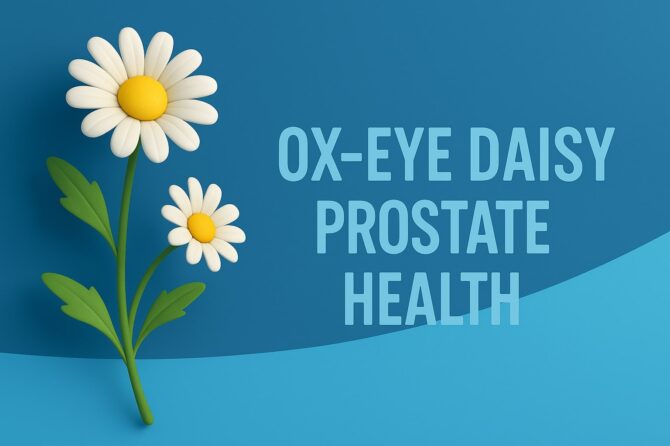
Ox-Eye Daisy (Leucanthemum vulgare) and Prostate Health: A Scholarly Overview
Taxonomy and Identity
- Scientific name: Leucanthemum vulgare Lam. (syn. Chrysanthemum leucanthemum)
- Common names: Ox-eye daisy, marguerite
- Family: Asteraceae (daisy family)
Ox-eye daisy is often confused with the common lawn daisy (Bellis perennis) and the ornamental Shasta daisy (Leucanthemum × superbum). Correct identification is essential, as chemical composition and traditional uses differ between species.
Phytochemistry (What’s in it?)
Modern analyses of ox-eye daisy flower-head essential oil reveal a complex mixture of monoterpenes and sesquiterpenes, with major constituents such as α-pinene, β-pinene, p-cymene, germacrene D, spathulenol, caryophyllene oxide, decanal, and others. Non-volatile fractions include tannins, flavonoids, saponins, mucilage, and bitter principles.
These compounds are known for their general anti-inflammatory, antimicrobial, and astringent properties, though their specific effects on the prostate have not been scientifically confirmed. The presence of volatile terpenes suggests possible benefits for inflammation and urinary health, but the data remain largely experimental.
Traditional and Ethnobotanical Uses
Historically, ox-eye daisy has been valued in European and North American folk medicine for:
- Urinary complaints: Used as a mild diuretic and astringent for urinary discomfort and blood in urine.
- Respiratory issues: Taken to ease coughs and bronchial irritation.
- Wound care: Applied topically for bruises and minor injuries.
These uses are based on traditional knowledge and anecdotal evidence rather than modern clinical studies.
Effects on Prostate Health
Benign Prostatic Hyperplasia (BPH)
There are no clinical studies directly examining ox-eye daisy for BPH treatment. Other herbs like saw palmetto (Serenoa repens), pumpkin seed extract, and Pygeum africanum have documented, though modest, effects on BPH symptoms. Any potential benefits of ox-eye daisy would likely come from its general anti-inflammatory or mild diuretic actions, but these effects remain speculative.
Chronic Prostatitis/Chronic Pelvic Pain Syndrome (CP/CPPS)
There is no evidence linking ox-eye daisy to improvement in CP/CPPS. While some flower pollen extracts from other plant species have shown promise, ox-eye daisy has not been evaluated in this context.
Summary:
Currently, there is no scientific proof that ox-eye daisy can reduce prostate size, improve urinary flow, or alleviate prostate inflammation. Any perceived benefit is purely traditional and unverified by modern science.
Urinary Tract & Lower Urinary Tract Symptoms (LUTS)
Ox-eye daisy has historically been used as a mild diuretic, helping to increase urine output and relieve discomfort. Herbalists have used infusions of the plant for urinary frequency, urgency, and bladder irritation.
However, no modern clinical trials confirm its efficacy for urinary tract infections (UTIs) or other urinary issues. Therefore, while it may provide mild support, it should never replace medical evaluation and treatment.
Pharmacological Insights (Speculative)
Based on its phytochemistry, several components may play roles in urinary health:
- Astringent tannins may soothe mucous membranes and reduce irritation.
- Volatile terpenes like α-pinene and caryophyllene oxide exhibit general anti-inflammatory and antimicrobial actions in laboratory settings.
However, these mechanisms remain theoretical and have not been studied specifically for prostate or urinary disorders.
Safety, Contraindications, and Interactions
- Allergies: As a member of the Asteraceae family, ox-eye daisy can cause allergic reactions in individuals sensitive to ragweed, mugwort, or similar plants.
- Essential oil caution: The essential oil may contain α-thujone and camphor, which are neuroactive compounds. Internal consumption of essential oil is not recommended.
- Pregnancy and breastfeeding: Safety has not been established; avoid use.
- Drug interactions: While none are well-documented, caution is advised when combined with diuretic medications due to potential additive effects.
Ingestion Methods (Traditional)
These methods are traditional and not supported by clinical evidence. Anyone with prostate or urinary concerns should consult a healthcare professional before use.
- Infusion (Tea):
- Steep 1–2 teaspoons of dried flowers or aerial parts in hot water for 10–15 minutes. Drink up to 2–3 times daily.
- Decoction:
- Simmer the plant material in water for several minutes to extract its components. Traditionally used as a mild diuretic.
- Topical Applications:
- Historically, ox-eye daisy was applied as a wash or poultice for bruises or wounds. This is unrelated to prostate or urinary health.
- Essential Oil:
- Not recommended for internal use due to potential toxicity.
Note: There are no standardized extracts or dosage guidelines for prostate health.
Practical Recommendations for Men’s Health
- For prostate enlargement or urinary symptoms, consider well-researched herbal supplements like saw palmetto, pumpkin seed oil, or Pygeum, which have at least some evidence supporting their use.
- Ox-eye daisy should be seen as a traditional supportive herb, not a primary treatment.
- Persistent urinary symptoms should be evaluated by a healthcare provider to rule out serious conditions such as BPH, prostatitis, or prostate cancer.
Knowledge Gaps and Research Needs
- No human clinical trials on ox-eye daisy for prostate or urinary conditions.
- Lack of standardized extracts and dosing information.
- Need for modern pharmacological studies to explore its potential anti-inflammatory or diuretic effects.
Conclusion
Ox-eye daisy (Leucanthemum vulgare) is a traditional herb with historical uses as a diuretic and urinary tonic. While it contains compounds with potential anti-inflammatory and antimicrobial activity, no scientific evidence currently supports its use for prostate health or urinary disorders. It should be regarded as an adjunctive, traditional remedy rather than a proven therapy. Men with urinary or prostate issues should prioritize evidence-based treatments and professional medical advice.
Leave a reply

Leave a reply